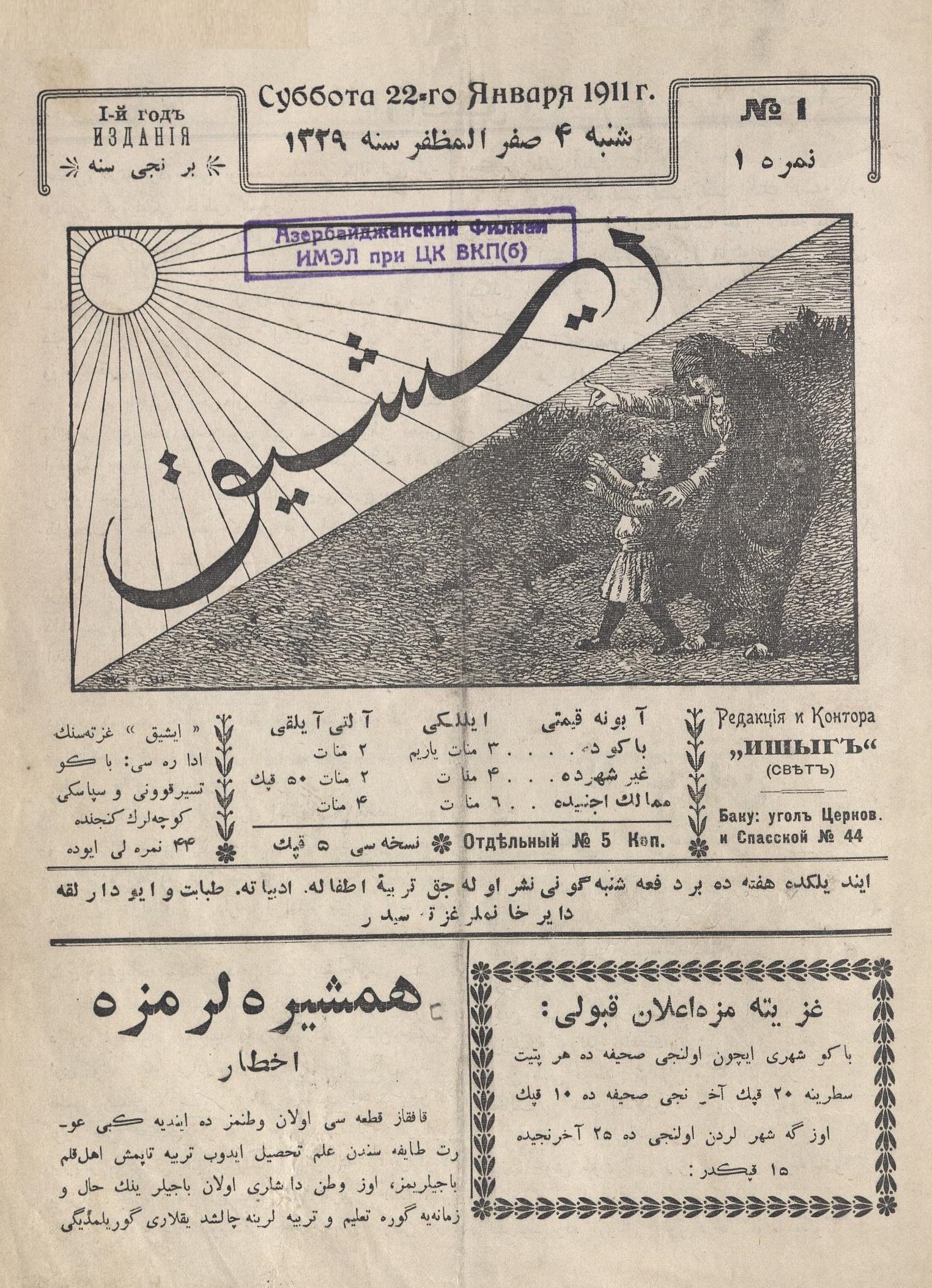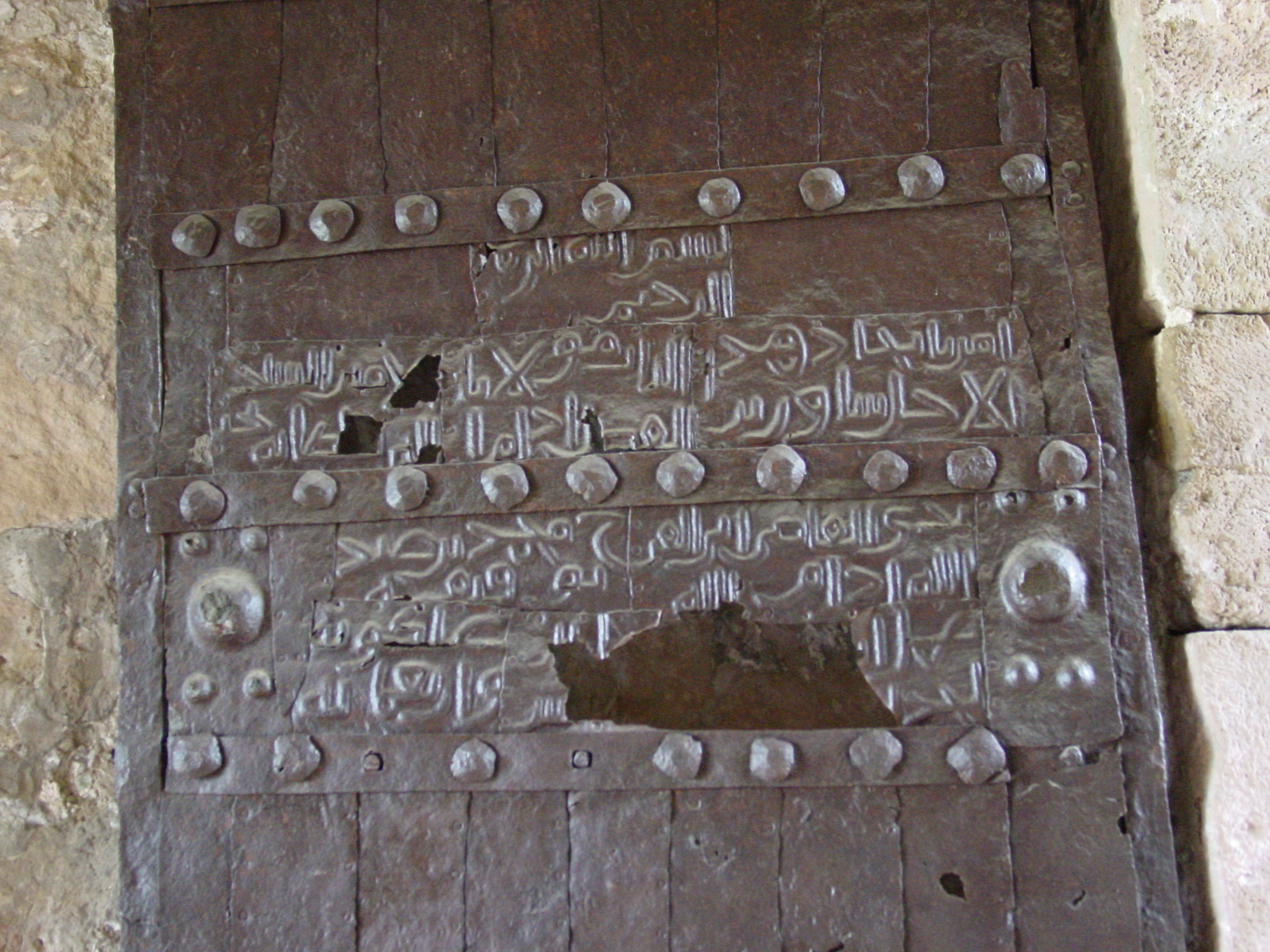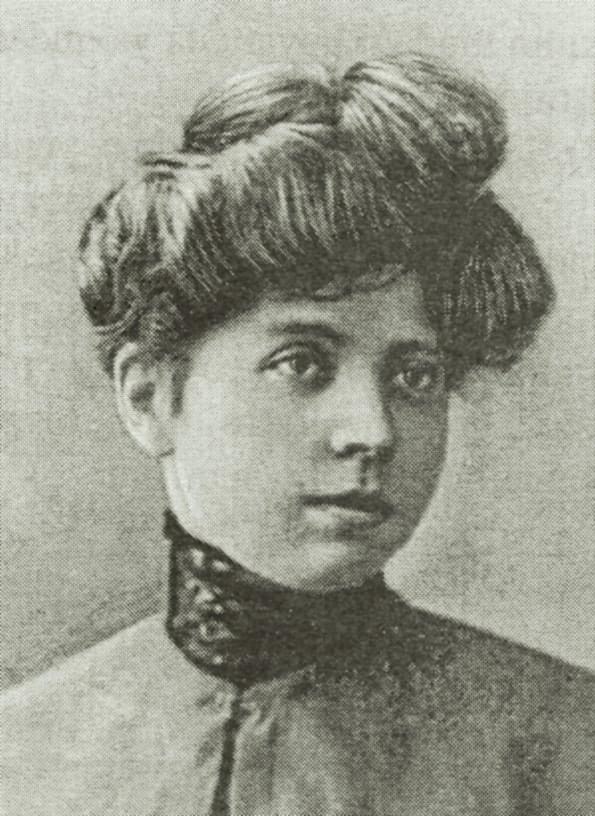|
Mustafa Bey Alibeyov
Mustafa Bey Alibeyov (1872, Shaki, Azerbaijan, Nukha - 1945) was a publicist, writer, playwright, and lawyer. He was the publisher of Ishig, Ishig newspaper, a member of "Nijat" charity society, "Help to the needy" society, secretary of Hidayat Charitable Society, "Hidayat" charity society, and a member of Ahrar Party (Azerbaijan), Ahrar party. Life and education Mustafa Bey Alibeyov was born in 1872 in the city of Shaki, Azerbaijan, Sheki in Azerbaijan. In his first years of education, he learned the Arabic-Persian languages perfectly. He studied at the Russian-Tatar school in Sheki. He graduated from Tiflis gymnasium in 1892. During these years, he studied Russian and French. Career and social activity In 1892, he started working as a translator of the chief investigator in the district court of Baku Governorate, Baku governorate. He was a member of "Nijat" charitable society. In addition to being famous as a lawyer, he was also known as a literary critic. He worked as a ... [...More Info...] [...Related Items...] OR: [Wikipedia] [Google] [Baidu] |
Shaki, Azerbaijan
Shaki (, ) is a city in northwestern Azerbaijan, surrounded by the district of the same name. It is located in the southern part of the Greater Caucasus mountain range, from Baku. As of 2020, it has a population of 68,400. The center of the city and the Palace of Shaki Khans were inscribed in the UNESCO World Heritage List in 2019 because of their unique architecture and history as an important trading center along the Silk Road. Etymology According to the Azerbaijani historians, the name of the town goes back to the ethnonym of the Sakas, who reached the territory of modern-day Azerbaijan in the 7th century B.C. and populated it for several centuries. In the medieval sources, the name of the town is found in various forms such as Sheke, Sheki, Shaka, Shakki, Shakne, Shaken, Shakkan, Shekin. The city was known as ''Nukha'' (; ) until 1968. History Antiquity There are traces of large-scale settlements in Shaki dating back to more than 2700 years ago. The Sakas were an I ... [...More Info...] [...Related Items...] OR: [Wikipedia] [Google] [Baidu] |
Azerbaijan Democratic Republic
The Azerbaijan Democratic Republic (), also known as the Azerbaijan People's Republic (; ), was the first secular democracy, democratic republic in the Turkic peoples, Turkic and Muslim worlds. *Tadeusz Swietochowski. ''Russia and Azerbaijan: A Borderland in Transition''. Columbia University Press, 1995. , . * Reinhard Schulze. ''A Modern History of the Islamic World''. I.B.Tauris, 2000. , . Citations are at Talk:Azerbaijan Democratic Republic#First or second The ADR was founded by the Azerbaijani National Council in Tbilisi, Tiflis on 28 May 1918 after the collapse of the Transcaucasian Democratic Federative Republic, and ceased to exist on April 28, 1920. Its established borders were with Russian Soviet Federative Socialist Republic, Russia to the north, the Democratic Republic of Georgia to the north-west, the First Republic of Armenia, Republic of Armenia to the west, and Qajar Iran, Iran to the south. It had a population of around 3 million. Ganja, Azerbaijan, Ganja was the ... [...More Info...] [...Related Items...] OR: [Wikipedia] [Google] [Baidu] |
Azerbaijani Jurists
Azerbaijani may refer to: * Somebody or something related to Azerbaijan * Azerbaijanis * Azerbaijani language See also * Azerbaijan (other) * Azeri (other) * Azerbaijani cuisine * Culture of Azerbaijan The culture of Azerbaijan () combines a diverse and heterogeneous set of elements which developed under the influence of Iranian peoples, Iranic, Turkic peoples, Turkic and Peoples of the Caucasus, Caucasian cultures. Azerbaijani culture include ... * {{Disambig Language and nationality disambiguation pages ... [...More Info...] [...Related Items...] OR: [Wikipedia] [Google] [Baidu] |
1945 Deaths
1945 marked the end of World War II, the fall of Nazi Germany, and the Empire of Japan. It is also the year Nazi concentration camps, concentration camps were liberated and the only year in which atomic weapons Atomic bombings of Hiroshima and Nagasaki, have been used in combat. Events World War II will be abbreviated as “WWII” January * January 1 – WWII: ** Nazi Germany, Germany begins Operation Bodenplatte, an attempt by the ''Luftwaffe'' to cripple Allies of World War II, Allied air forces in the Low Countries. ** Chenogne massacre: German prisoners are allegedly killed by American forces near the village of Chenogne, Belgium. * January 6 – WWII: A German offensive recaptures Esztergom, Kingdom of Hungary (1920–1946), Hungary from the Soviets. * January 9 – WWII: American and Australian troops land at Lingayen Gulf on western coast of the largest Philippine island of Luzon, occupied by Japan since 1942. * January 12 – WWII: The Soviet Union begins the Vis ... [...More Info...] [...Related Items...] OR: [Wikipedia] [Google] [Baidu] |
1872 Births
Events January * January 12 – Yohannes IV is crowned Emperor of Ethiopian Empire, Ethiopia in Axum, the first ruler crowned in that city in over 500 years. *January 20 – The Cavite mutiny was an uprising of Filipino military personnel of Fort San Felipe (Cavite), Fort San Felipe, the Spanish arsenal in Cavite, Philippine Islands.Foreman, J., 1906, The set course for her patrol area off the northeastern coast of the main Japanese island Honshū. She arrived, New York: Charles Scribner's Sons February * February 2 – The government of the United Kingdom buys a number of forts on the Gold Coast (region), Gold Coast, from the Netherlands. * February 4 – A great solar flare, and associated geomagnetic storm, makes northern lights visible as far south as Cuba. * February 13 – Rex parade, Rex, the most famous parade on Mardi Gras, parades for the first time in New Orleans for Grand Duke Alexei Alexandrovich of Russia. * February 17 – Filipino peo ... [...More Info...] [...Related Items...] OR: [Wikipedia] [Google] [Baidu] |
Khadija Alibeyova
Khadija Alibeyova (, 1884 – 1961) was the first female editor in Azerbaijan, and also an educator, publicist and publisher. She is also credited as the first female gynecologist physician in Azerbaijan in some sources. Personal life and family Khadija Subhangulova was born in 1884 in Tbilisi. Her father, Aladdin Subhanguliyev, was a respected intellectual in Tbilisi and was deeply committed to educating his daughter. After graduating from the Tbilisi Girls Gymnasium, Khadija studied medicine at the Transcaucasian Olginski Institute of Obstetrics and Gynecology. She was married to the famous Azerbaijani lawyer and publicist Mustafa Bey Alibeyov in 1907. They had six children and one of them passed away at a young age. All five remaining children received higher education. Their daughter, Aruziyya Alibeyova, was the first economics doctor in Azerbaijan. Career After her marriage to Alibeyov, she became more actively involved in social and cultural life. Khadija Alibeyova beca ... [...More Info...] [...Related Items...] OR: [Wikipedia] [Google] [Baidu] |
Palace Of Shaki Khans
The Palace of Shaki Khans () in Shaki, northwestern Azerbaijan, is a historic monument that once served as the summer residence of the Shaki khans. It was constructed in 1797 under the rule of Muhammad Husayn Khan Mushtaq. The palace is renowned for its distinctive spatial composition, richly decorated interiors, and harmonious integration with the surrounding natural environment. It stands as a notable example of Eastern architecture, reflecting influences from Persian and Ottoman stylistic traditions. The Palace of Shaki Khans was nominated for inclusion on the UNESCO World Heritage List in 1998 by Gulnara Mehmandarova, then President of the Azerbaijan Committee of the International Council on Monuments and Sites (ICOMOS). On 7 July 2019, the historic centre of Shaki, including the Khan’s Palace, was inscribed as a UNESCO World Heritage Site. Geographical area Situated in the north-west of the country at an elevation of 632 meters above sea level, the town of Sheki li ... [...More Info...] [...Related Items...] OR: [Wikipedia] [Google] [Baidu] |
Ganja, Azerbaijan
Ganja (; ) is Azerbaijan's List of cities in Azerbaijan, third largest city, with a population of around 335,600.Azərbaycan Respublikası. — 2. Azərbaycan Respublikasının iqtisadi və inzibati rayonları. — 2.4. Azərbaycan Respublikasının iqtisadi və inzibati rayonlarının ərazisi, əhalisinin sayı və sıxlığı, səhifə 66. /Azərbaycanın əhalisi (statistik bülleten) Müəllifi: State Statistics Committee, Azərbaycan Respublikasının Dövlət Statistika Komitəsi. Buraxılışa məsul şəxs: Rza Allahverdiyev. Bakı — 2015, 134 səhifə. The city has been a historic and cultural center throughout most of its existence. It was the capital of the Ganja Khanate until 1804; after Qajar Iran ceded it to the Russian Empire following the Treaty of Gulistan in 1813, it became part of the administrative divisions of the Georgia Governorate, Georgia-Imeretia Governorate, Tiflis Governorate, and Elizavetpol Governorate. Following the dissolution of the Russian Emp ... [...More Info...] [...Related Items...] OR: [Wikipedia] [Google] [Baidu] |
Red Army Invasion Of Azerbaijan
The Red Army invasion of Azerbaijan, also known as the Sovietization or Soviet invasion of Azerbaijan, took place in April 1920. It was a military campaign conducted by the 11th Army of Soviet Russia with the aim of installing a new Soviet government in the Azerbaijan Democratic Republic. This invasion occurred simultaneously with an anti-government insurrection organized by local Azerbaijani Bolsheviks in the capital city of Baku. As a result of the invasion, the Azerbaijan Democratic Republic was dissolved, and the Azerbaijan Soviet Socialist Republic was established. During 1919–1920, Azerbaijan was grappling with a severe political and socio-economic crisis, and the internal political situation was highly volatile. Armed conflicts were occurring between various political and social factions across the provinces of the country. Simultaneously, since the collapse of Soviet power in 1918, underground organizations comprising diverse political parties and socialist-oriented grou ... [...More Info...] [...Related Items...] OR: [Wikipedia] [Google] [Baidu] |
Ottoman Empire
The Ottoman Empire (), also called the Turkish Empire, was an empire, imperial realm that controlled much of Southeast Europe, West Asia, and North Africa from the 14th to early 20th centuries; it also controlled parts of southeastern Central Europe, between the early 16th and early 18th centuries. The empire emerged from a Anatolian beyliks, ''beylik'', or principality, founded in northwestern Anatolia in by the Turkoman (ethnonym), Turkoman tribal leader Osman I. His successors Ottoman wars in Europe, conquered much of Anatolia and expanded into the Balkans by the mid-14th century, transforming their petty kingdom into a transcontinental empire. The Ottomans ended the Byzantine Empire with the Fall of Constantinople, conquest of Constantinople in 1453 by Mehmed II. With its capital at History of Istanbul#Ottoman Empire, Constantinople (modern-day Istanbul) and control over a significant portion of the Mediterranean Basin, the Ottoman Empire was at the centre of interacti ... [...More Info...] [...Related Items...] OR: [Wikipedia] [Google] [Baidu] |
Ishig
''Ishig'' was the first Azerbaijani-language women's publication. The first issue of newspaper was published on January 22, 1911, and its publication continued until the end of 1912, during which 68 issues were released. Background Although the first women's publication in Russia Empire was the magazine ''Nevinnoye uprajneniya'' ( - "Innocent Exercises"), edited by Princess Dashkova in the 18th century, the advocacy magazine for women's rights, ''Soyuz jenshin'' ( - Women's Union), was published between 1907 and 1909. In the social life of Russian Turks, the first women's magazine was '' Alem-i-nisvan''. It was edited by Şefiqa Gaspıralı, the daughter of Ismail bey Gasprinski, the editor of the '' Terciman'' newspaper. Meanwhile, in the Ottoman Empire, there were two publications for women - the weekly illustrated magazines ''Kadinlar Gazetesi'' and ''Nisvan''. In the early years following Azerbaijan's Sovietization, the magazine ''Sharg gadini'' (Oriental woman) was publis ... [...More Info...] [...Related Items...] OR: [Wikipedia] [Google] [Baidu] |








